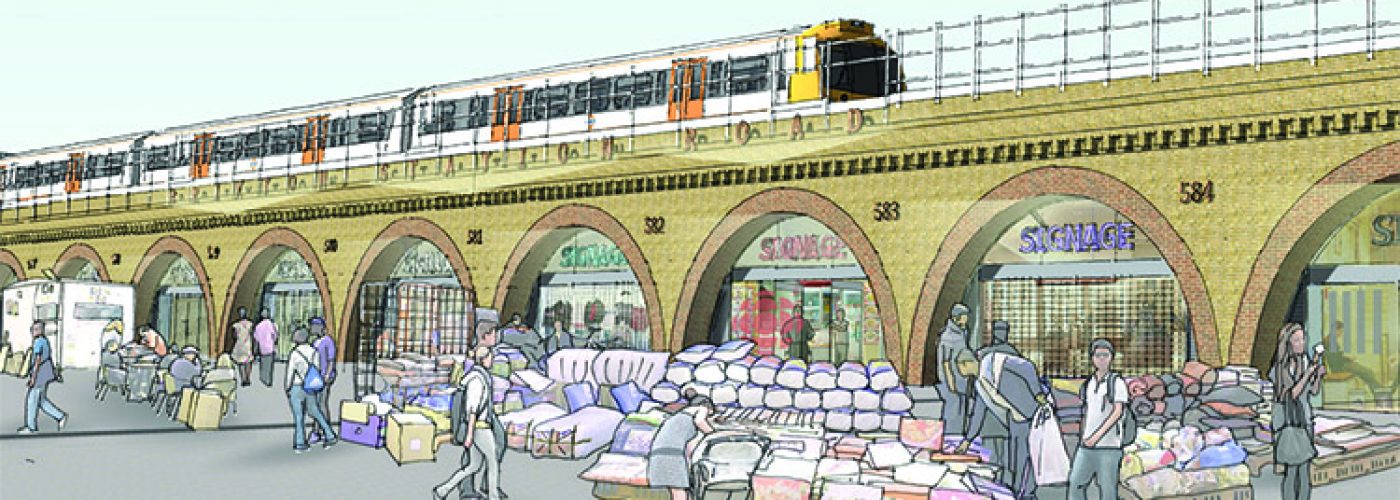13 August 2016 – by Janie Manzoori-Stamford
When consent was given for Network Rail’s plans to redevelop Brixton Arches, protesters came out in force.

Nothing livens up a planning meeting like a glitter bomb. A shower of blood-red sparkles raining down amid catcalls of angry protest is a far more spirited conclusion to nearly three hours of discussion than a call for any other business. Especially when it is followed by the arrival of several uniformed police officers, drafted in to keep the peace. So very bohemian, so very Brixton.
This is exactly what happened last week when Lambeth Council’s planning committee meeting, held in public at the Karibu Centre on Gresham Road, SW9, voted six to one in favour of proposals to redevelop the railway arches beneath Brixton rail station. The site is currently home to an eclectic mix of independent traders, including a fishmonger, carpet seller and hair salon.
Landlord Network Rail says it aims to “enhance the character and improve the fabric and structural integrity” of the arches. Over the course of a 12-month, £8m revamp beginning at the end of this month, it says the plans will rejuvenate an important part of Brixton’s cultural heritage.
New shop frontages, 26 re-clad units and 13 new kiosks are among the plans to improve the “commercial attractiveness” of the arches which the public sector body says will bring them in line with other Brixton retailers, increase footfall and help boost the local economy.
But not everyone is on board. Apart from the glitter bombing protesters, a petition objecting to Network Rail’s proposal has attracted nearly 30,000 signatures. This is just one chapter in the ongoing debate around gentrification in London – for which Brixton has become the poster child. So just how could the transformation of such an historic fixture on Brixton’s retail landscape contribute to the on-going debate around pros and cons of “premiumisation” in London?
All the content from this weekís magazine, including this article, is available in the new app.
On paper, the arches scheme looks to have real potential to boost regeneration efforts in an area that has in the past been known for crime and poverty.
Back in 2001 the centre of Brixton was described by a police chief as a “24-hour crack supermarket”. These days the visitors it attracts from across London are more likely to be there for a gourmet burger or a craft beer in the thriving food and drink hub of Brixton Village, housed in three bustling arcades that were previously home to covered markets.
And as Brixton’s desirability has shot up, so too have house prices. Residential property values have increased by 128% in the last 10 years, with the average price of a semi-detached house in Brixton now topping £1m.
The cost of renting also shows how far Brixton has come. On average, a one-bedroom property in Brixton rents for £1,744 pcm (up by 23% year-on-year), just £43 less than nearby and traditionally more affluent, Clapham, according to Zoopla. It is certainly a positive story from a landlord perspective, but at what cost?
Network Rail says that to achieve its refurbishment ambitions, it needs to terminate the leases of the current occupiers. Around 30 independent traders and tenants, many of which have occupied and worked out of
the space for upwards of 25 years, are to be evicted on 19 August. And they are not happy about it.
“When Brixton was bad, we were good,” says Riccardo Festa, who owns menswear store The Baron, which his grandfather opened on the Atlantic Road side of Brixton Arches in 1974. “But now that Brixton is good, we are bad.”
Festa, who has around 11 years left to run on his 20-year lease, is convinced that his landlord wants the current occupiers out because more money can be made from new tenants. And this is despite an offer by Network Rail to return to a refurbished arch – not necessarily the same one that was vacated – after works complete, with discounted stepped rents over seven years.
This means that the 2015 market rate, which Network Rail has determined as being more than double what tenants currently pay, will not be imposed on returning occupiers until 2024. It is a strong offer and one that the company says it does not do anywhere else. But is it affordable?
Click here to read more





